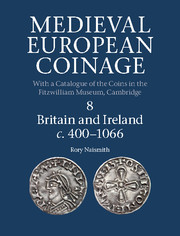Book contents
- Frontmatter
- Contents
- List of plates
- List of figures
- List of maps
- List of tables
- Preface
- Note on spelling
- List of abbreviations
- 1 Introduction
- 2 From Roman Britain To Anglo-Saxon England
- 3 Early Anglo-Saxon Gold Coinage
- 4 The Early Silver Pennies
- 5 The Kingdom Of Northumbria
- 6 The ‘Mercian Supremacy’ In The Age Of Offa And Coenwulf
- 7 The Rise Of Wessex In Southern England
- 8 The Reign Of Alfred The Great
- 9 England From Edward The Elder To Edgar's Reform
- 10 The Late Anglo-Saxon Coinage
- 11 The Anglo-Viking Coinages
- 12 Wales And Scotland
- 13 The Isle Of Man And ‘Irish Sea’ Coinages
- 14 Ireland To 1170 (with Andrew Woods)
- APPENDICES
- Bibliography
- CATALOGUE
- Concordances
- Indexes
13 - The Isle Of Man And ‘Irish Sea’ Coinages
Published online by Cambridge University Press: 11 May 2017
- Frontmatter
- Contents
- List of plates
- List of figures
- List of maps
- List of tables
- Preface
- Note on spelling
- List of abbreviations
- 1 Introduction
- 2 From Roman Britain To Anglo-Saxon England
- 3 Early Anglo-Saxon Gold Coinage
- 4 The Early Silver Pennies
- 5 The Kingdom Of Northumbria
- 6 The ‘Mercian Supremacy’ In The Age Of Offa And Coenwulf
- 7 The Rise Of Wessex In Southern England
- 8 The Reign Of Alfred The Great
- 9 England From Edward The Elder To Edgar's Reform
- 10 The Late Anglo-Saxon Coinage
- 11 The Anglo-Viking Coinages
- 12 Wales And Scotland
- 13 The Isle Of Man And ‘Irish Sea’ Coinages
- 14 Ireland To 1170 (with Andrew Woods)
- APPENDICES
- Bibliography
- CATALOGUE
- Concordances
- Indexes
Summary
HISTORICAL INTRODUCTION
The Irish Sea was a unifying as well as a dividing feature in the Middle Ages. Commodities, cultures and languages as well as political aspirations were conveyed across it at various times. This is nowhere better illustrated than in the complex history of the Isle of Man, which lies at the heart of the Irish Sea, and was linked to Ireland, Scotland, Wales and England, as well as to the other islands off the west coast of Scotland. Written sources relating to the island are very few (cf. Bornholdt Collins 2003, 41–51 and Appendix 2; Duffy 2015), and (apart from a number of inscriptions) the only native text relating to the earlier medieval period is the thirteenth-century Chronicle of the Kings of Man and the Isles (Cronica regum Manniæ et insularum), which includes material relating to Man from 1066 onwards (Broderick 1996). Otherwise, reconstruction of events relating to the island depends on those few foreign historical texts (principally Irish, with some contribution from English and Welsh) which mention Man in various connections. These writings can be used to weave a loose narrative from the ninth century onwards (Bornholdt Collins 2003, 51–73). However, other resources to some extent compensate for Man's weak representation in the historical record: it possesses rich archaeological remains, including an impressive selection of stone sculpture and burials (Wilson 2008), as well as the evidence offered by its place names (Broderick 1994 – 2005; Fellows-Jensen 1978; 1983; Gelling 1970; 1971; 1991). Some of this evidence reflects the influence of Scandinavian settlers who arrived on the island in the course of the tenth century (Wilson 1974; 2008; Crawford 2015).
Prior to the arrival of the Vikings, Man was a Brittonic-speaking territory, frequently considered alongside Anglesey as one of the Mevanian islands (Bede, HE ii.5, 9; cf. Dumville 1997a, 23–4). It played host to political exiles from elsewhere in the Insular world, and at times in the sixth century was the target of Irish and Dalriadan attacks; Irish connections are also signalled by the presence of ogham inscriptions (Anderson 1922, 89; Ó Cróinín 1995, 50).
- Type
- Chapter
- Information
- Medieval European Coinage , pp. 315 - 322Publisher: Cambridge University PressPrint publication year: 2017

